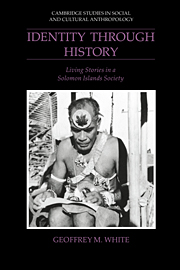Book contents
- Frontmatter
- Contents
- List of illustrations
- Preface
- Acknowledgments
- Orthography
- 1 Introduction
- I ORIENTING
- II TRANSFORMING
- III NARRATING
- 7 Becoming Christian: playing with history
- 8 Missionary encounters: narrating the self
- IV REVITALIZING
- Notes
- References
- Index
- Cambridge Studies in Social and Cultural Anthropology
8 - Missionary encounters: narrating the self
Published online by Cambridge University Press: 12 January 2010
- Frontmatter
- Contents
- List of illustrations
- Preface
- Acknowledgments
- Orthography
- 1 Introduction
- I ORIENTING
- II TRANSFORMING
- III NARRATING
- 7 Becoming Christian: playing with history
- 8 Missionary encounters: narrating the self
- IV REVITALIZING
- Notes
- References
- Index
- Cambridge Studies in Social and Cultural Anthropology
Summary
In July of 1890 the missionary Henry Welchman decided to take his message personally to the notorious “bush” chief Figrima living in his mountain fort at Khakatio (chapter 5). It was to be an epic encounter, one that Welchman hoped would open the door to the conversion of a large population of Cheke Holo people living in the vicinity of the fort, and one that local oral historians recreate with some regularity in speeches, songs and plays. These indigenous accounts allow further comparisons of the concepts, metaphors and narrative practices through which Cheke Holo speaking people represent the origins of Christianity in their region. And, because Welchman himself recorded an account of these events in his diary, we have an unusual interpretive opportunity to compare latter-day indigenous recollections with the written notes of one of the principal participants. This chapter exploits that opportunity by juxtaposing these accounts to examine the internal “logic” of indigenous conversion histories. By comparing different local versions of these events, and identifying several points of contrast with Welchman's description, the analysis highlights the social and creative processes that shape historical narrative.
Previous chapters have considered several local histories of Christian contact and conversion. On the one hand, similarities in metaphorical imagery and narrative structure of stories about widely divergent events (as different as the Knabu story and the Buala bina boli) are suggestive of the force of sociocultural models in shaping representations of the past.
- Type
- Chapter
- Information
- Identity through HistoryLiving Stories in a Solomon Islands Society, pp. 157 - 180Publisher: Cambridge University PressPrint publication year: 1991



